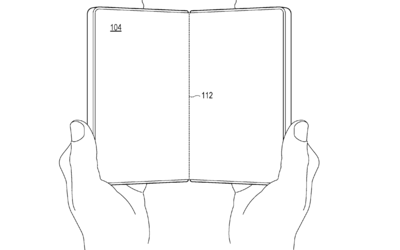Microsoft is exploring a new approach to foldable phone technology, hinting at a potential return to the mobile device market after the discontinuation of its Surface Duo line. A recent patent application reveals a novel hinge design aimed at addressing key challenges in foldable devices.

Despite the lukewarm reception of the Android-powered Surface Duo smartphones, Microsoft is not abandoning its ambition to innovate in the mobile space. The company's patent application, filed with the United States Patent and Trademark Office on February 29th, details a unique foldable device concept.
The patent centers around a "spine cover plate," a single-hinge technology designed to improve the durability and aesthetics of foldable smartphones.
The application suggests a book-style design reminiscent of the Samsung Galaxy Z Fold, featuring a flexible display. However, the primary focus is on the spine cover plate, a mechanism intended to protect the hinge system by encasing the structural elements.
A key differentiator between conventional hinges and Microsoft's design is the spine cover's ability to automatically adjust during opening and closing. This aims to eliminate gaps around the hinge, safeguarding it from dust and water ingress. While Samsung's foldables boast an IPX8 rating (water resistance), Microsoft's approach could potentially offer enhanced protection.
Furthermore, the patent indicates that the new hinge mechanism could minimize the visibility of the hinge crease, a common issue in foldable devices.
Microsoft also outlines methods to reduce the overall thickness of the foldable smartphone. By allowing the spine cover plate to move closer to the device's hinge when folded, the device's width can be reduced.
Microsoft explains in the patent that retracting the spine cover plate toward the central spine as the display-supporting frames rotate inwards reduces the width of the folded device. This promises easier and more comfortable one-handed operation.
The smartphone industry is actively seeking solutions to eliminate the crease in foldable displays. Some manufacturers have adopted water-drop folding mechanisms to mitigate the issue, but a truly crease-free foldable remains elusive. Moreover, the durability of foldable devices is a paramount concern, given their intricate moving parts.
Adding another movable component to the folding mechanism, despite the potential benefits and enhanced durability detailed in the patent application, raises questions about the design's long-term practicality.
Newer articles
Older articles
 Gavaskar Calls for Kuldeep Yadav's Inclusion in Second Test; Questions Bumrah's Fitness After Leeds Loss
Gavaskar Calls for Kuldeep Yadav's Inclusion in Second Test; Questions Bumrah's Fitness After Leeds Loss
 India's Harshit Rana Released from Test Squad Ahead of Second England Clash
India's Harshit Rana Released from Test Squad Ahead of Second England Clash
 Saucecode:
Nitish Rana Eyes Delhi Return After Disappointing Uttar Pradesh Spell
Saucecode:
Nitish Rana Eyes Delhi Return After Disappointing Uttar Pradesh Spell
 ICC Test Rankings: Pant Climbs to Career-Best, Bumrah Holds Top Spot as Root Reigns Supreme
ICC Test Rankings: Pant Climbs to Career-Best, Bumrah Holds Top Spot as Root Reigns Supreme
 India's Fielding Woes Blasted by Ex-Selector After Test Defeat Against England; Calls for Patience Amid Transition
India's Fielding Woes Blasted by Ex-Selector After Test Defeat Against England; Calls for Patience Amid Transition
 Elon Musk’s AI company will make Grok chatbot more accessible, here’s how
Elon Musk’s AI company will make Grok chatbot more accessible, here’s how
 India's Batting Collapses Trigger Debate: Gambhir Defends Lower Order, Cites Missed Catches, Workload Management as Factors in Test Loss
India's Batting Collapses Trigger Debate: Gambhir Defends Lower Order, Cites Missed Catches, Workload Management as Factors in Test Loss
 Bumrah's Birmingham Nets Spell: Accuracy, Angles, and Ambiguity Surround India Spearhead
Bumrah's Birmingham Nets Spell: Accuracy, Angles, and Ambiguity Surround India Spearhead
 IRCTC's AskDisha 2.0: AI Chatbot Streamlines Train Ticket Booking, Refunds, and Information Access
IRCTC's AskDisha 2.0: AI Chatbot Streamlines Train Ticket Booking, Refunds, and Information Access
 Wimbledon 2025: Alcaraz, Sabalenka, Fritz, and Anisimova Advance to Thrilling Semi-Final Showdowns
Wimbledon 2025: Alcaraz, Sabalenka, Fritz, and Anisimova Advance to Thrilling Semi-Final Showdowns